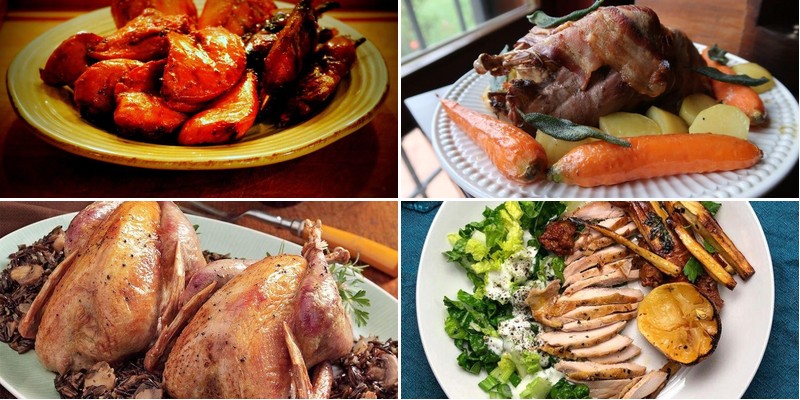Deliciously elegant yet surprisingly approachable, roast pheasant is the ultimate centerpiece for memorable meals. Whether you’re hosting a special dinner or simply craving something extraordinary, these recipes transform this lean, flavorful bird into everything from rustic comfort food to sophisticated showstoppers. Get ready to discover 28 irresistible ways to prepare pheasant that will have everyone asking for seconds—let’s dive into these mouthwatering delights!
Herb-Crusted Roast Pheasant with Wild Mushrooms
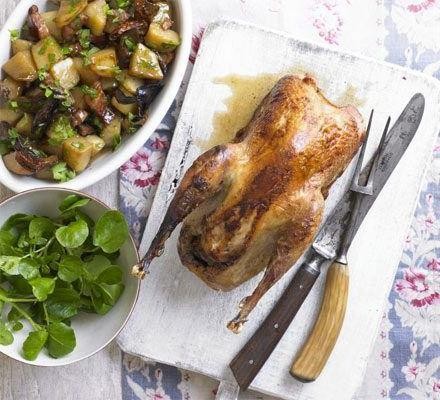
Kindness settles in the kitchen this time of year, when the air turns crisp and golden leaves whisper against the windowpane. There’s something deeply comforting about preparing a dish that honors the earth’s quiet offerings, like this herb-crusted roast pheasant nestled among wild mushrooms. It feels like a gentle ritual, each step a meditation on flavor and simplicity.
2
portions15
minutes65
minutesIngredients
– 1 whole pheasant (about 3 pounds)
– 2 tablespoons olive oil
– 1 tablespoon fresh thyme leaves
– 1 tablespoon fresh rosemary, finely chopped
– 1 teaspoon kosher salt
– 1/2 teaspoon black pepper
– 2 cups mixed wild mushrooms (such as chanterelles and morels), cleaned
– 1/2 cup dry white wine
– 1 cup chicken broth
– 2 tablespoons unsalted butter
Instructions
1. Preheat the oven to 375°F and position a rack in the center.
2. Pat the pheasant completely dry with paper towels to ensure a crisp skin.
3. Rub the pheasant all over with olive oil, covering every surface evenly.
4. In a small bowl, mix thyme, rosemary, salt, and pepper to create the herb crust.
5. Sprinkle the herb mixture evenly over the pheasant, gently pressing it into the skin.
6. Place the pheasant breast-side up in a roasting pan and arrange wild mushrooms around it.
7. Roast for 50–60 minutes, or until a meat thermometer inserted into the thickest part of the thigh reads 165°F.
8. Tip: Baste the pheasant with pan juices every 20 minutes to keep it moist and flavorful.
9. Transfer the pheasant to a cutting board and let it rest for 10 minutes to redistribute juices.
10. While resting, place the roasting pan on the stovetop over medium heat.
11. Pour in white wine, scraping up any browned bits from the pan bottom with a wooden spoon.
12. Tip: Deglazing with wine adds depth to the sauce and lifts flavorful stuck-on bits.
13. Add chicken broth and simmer for 5 minutes until the liquid reduces by half.
14. Whisk in butter until the sauce becomes glossy and slightly thickened.
15. Tip: Stir butter in off the heat to prevent the sauce from breaking.
16. Slice the pheasant and serve with wild mushrooms and pan sauce drizzled over top.
This dish yields tender, juicy meat with a fragrant herb crust that crackles delicately with each bite. The wild mushrooms add an earthy depth, while the pan sauce ties everything together with a silky, aromatic finish. Try serving it over creamy polenta or alongside roasted root vegetables to highlight its rustic elegance.
Citrus-Infused Pheasant with Roasted Vegetables
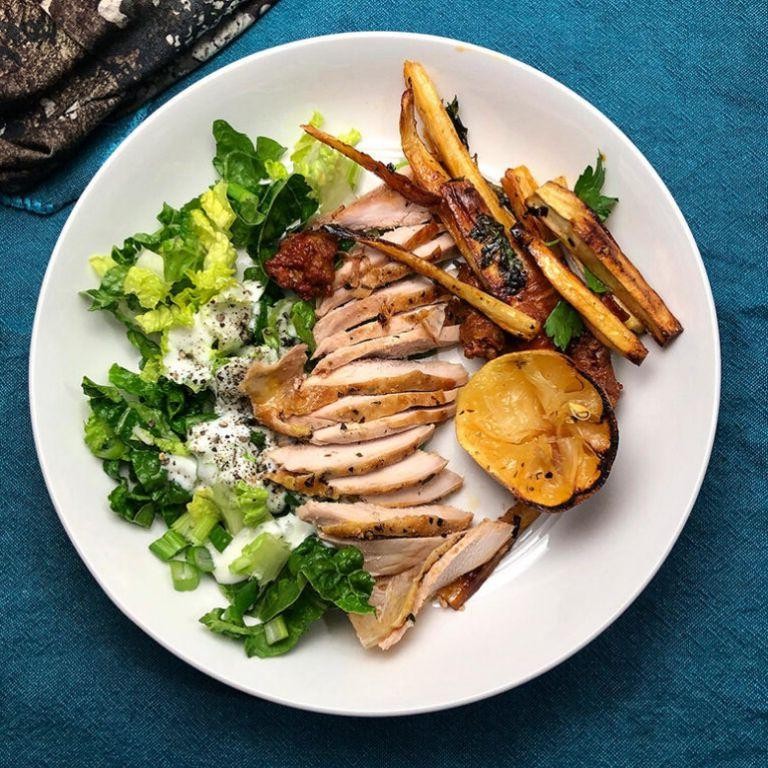
Zephyrs of autumn air carry whispers of change, and in my kitchen today, I find myself drawn to the quiet ritual of preparing something that honors both the season’s bounty and its gentle melancholy. Citrus-Infused Pheasant with Roasted Vegetables feels like the perfect companion for this reflective afternoon, a dish that asks for patience and rewards it with layers of subtle flavor.
3
servings20
minutes85
minutesIngredients
– 1 whole pheasant (3-4 lbs)
– 2 tbsp olive oil
– 1 tsp kosher salt
– 1/2 tsp black pepper
– 2 oranges
– 1 lemon
– 4 sprigs fresh thyme
– 2 sprigs fresh rosemary
– 3 carrots
– 1 lb baby potatoes
– 1 large red onion
– 3 cloves garlic
Instructions
1. Preheat your oven to 375°F.
2. Pat the pheasant completely dry with paper towels inside and out.
3. Rub the pheasant evenly with 1 tablespoon of olive oil.
4. Season the pheasant inside and out with kosher salt and black pepper.
5. Cut one orange and the lemon into thin slices.
6. Stuff the pheasant cavity with the citrus slices, thyme sprigs, and rosemary sprigs.
7. Tie the pheasant legs together with kitchen twine to help maintain its shape during roasting.
8. Place the pheasant breast-side up in a large roasting pan.
9. Peel the carrots and cut them into 2-inch pieces.
10. Halve the baby potatoes if they’re larger than 1 inch in diameter.
11. Peel and quarter the red onion.
12. Peel the garlic cloves and leave them whole.
13. Toss the carrots, potatoes, red onion, and garlic with the remaining 1 tablespoon of olive oil in a bowl.
14. Arrange the vegetables around the pheasant in the roasting pan.
15. Roast in the preheated oven for 60-75 minutes, until the pheasant skin is golden brown and crisp.
16. Check for doneness by inserting an instant-read thermometer into the thickest part of the thigh – it should read 165°F.
17. Remove the roasting pan from the oven and transfer the pheasant to a cutting board.
18. Let the pheasant rest for 15 minutes before carving to allow juices to redistribute.
19. While the pheasant rests, return the vegetables to the oven for 10 more minutes to achieve deeper caramelization.
20. Squeeze juice from the remaining orange over the carved pheasant before serving. You’ll notice the citrus-infused meat remains remarkably moist and tender, with the roasted vegetables developing sweet, caramelized edges that contrast beautifully with the pheasant’s delicate gaminess. Yesterday’s leftovers make wonderful tacos when shredded and warmed with a splash of the pan juices, proving this dish’s generous nature extends beyond the first serving.
Savory Stuffed Pheasant with Sage and Chestnuts
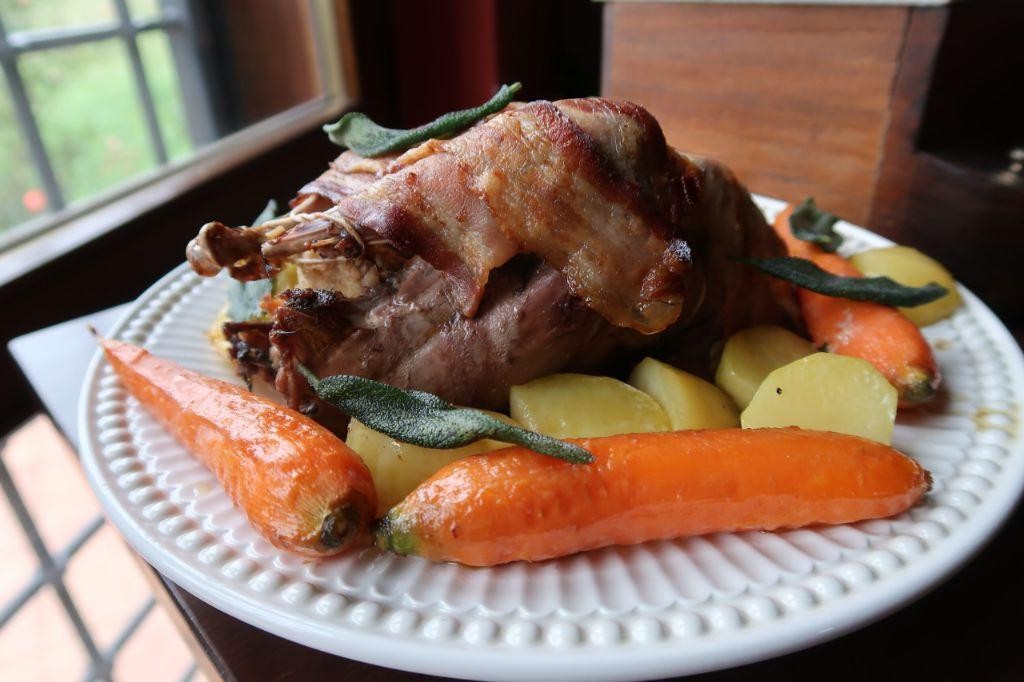
Gently, as the afternoon light fades outside my kitchen window, I find myself drawn to this recipe—a quiet, comforting dish that feels like wrapping yourself in a warm blanket on a crisp autumn evening. There’s something deeply soothing about preparing a stuffed pheasant, each step a mindful pause in the day’s rush, filling the air with the earthy scent of sage and the rich promise of chestnuts. It’s a meal that asks for patience, rewarding you with flavors that unfold slowly, like a story told by firelight.
2
portions20
minutes50
minutesIngredients
- 1 whole pheasant (about 3 pounds)
- 2 tablespoons olive oil
- 1 teaspoon salt
- 1/2 teaspoon black pepper
- 1 cup chestnuts, roasted and peeled
- 1/4 cup fresh sage leaves, chopped
- 1/2 cup unsalted butter, softened
- 1 small onion, finely diced
- 1/2 cup dry white wine
- 1 cup chicken broth
Instructions
- Preheat your oven to 375°F and position a rack in the center.
- Pat the pheasant dry inside and out with paper towels to ensure crisp skin.
- Rub the pheasant all over with olive oil, then season evenly with salt and black pepper.
- In a medium bowl, combine the chestnuts, sage, and softened butter, mixing until well incorporated.
- Gently loosen the skin over the pheasant breast and thighs with your fingers, being careful not to tear it.
- Spread the chestnut-sage butter evenly under the skin, covering the breast and thigh areas.
- Truss the pheasant with kitchen twine to help it cook evenly and retain its shape.
- Place the pheasant breast-side up in a roasting pan and scatter the diced onion around it.
- Roast in the preheated oven for 45 minutes, or until the skin is golden brown and the internal temperature at the thigh reaches 165°F.
- Remove the pheasant from the oven, transfer it to a cutting board, and let it rest for 10 minutes to redistribute juices.
- While the pheasant rests, place the roasting pan on the stovetop over medium heat.
- Pour the white wine into the pan, scraping up any browned bits with a wooden spoon to build flavor.
- Add the chicken broth and simmer for 5 minutes, until the sauce reduces slightly and thickens.
- Strain the sauce through a fine-mesh sieve into a serving bowl, discarding the solids.
- Carve the pheasant into serving pieces and arrange on a platter.
- Drizzle the warm sauce over the carved pheasant just before serving.
Velvety and rich, the pheasant emerges tender beneath its crisp skin, with the chestnuts adding a subtle sweetness that balances the earthy sage. Serve it alongside roasted root vegetables or a simple wild rice pilaf to soak up the fragrant pan sauce, making each bite a quiet celebration of autumn’s bounty.
Classic Roast Pheasant with Red Wine Jus
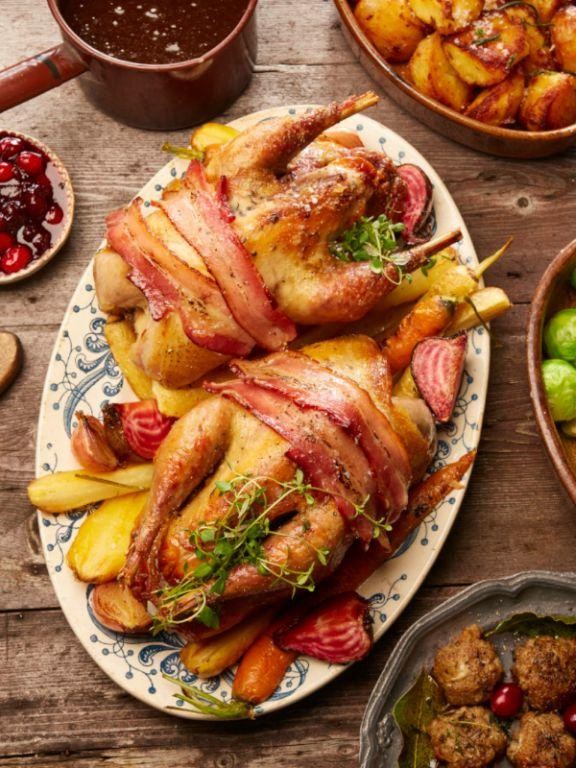
Zephyrs of autumn air carry memories of harvest tables, where the rich aroma of game birds mingled with woodsmoke and laughter. There’s something quietly ceremonial about preparing a pheasant, its golden skin promising deep, earthy flavors and tender meat beneath. Today, I’m revisiting that tradition with a classic roast, accompanied by a glossy red wine jus that whispers of vineyards and cool evenings.
4
servings15
minutes67
minutesIngredients
– 1 whole pheasant (about 3 lbs)
– 2 tbsp olive oil
– 1 tsp kosher salt
– 1/2 tsp black pepper
– 4 sprigs fresh thyme
– 1/2 cup dry red wine
– 1 cup chicken broth
– 1 tbsp unsalted butter
Instructions
1. Preheat your oven to 375°F.
2. Pat the pheasant completely dry with paper towels inside and out.
3. Rub the pheasant all over with olive oil.
4. Season the pheasant evenly inside and out with kosher salt and black pepper.
5. Place the fresh thyme sprigs inside the pheasant cavity.
6. Truss the pheasant legs together with kitchen twine to help it cook evenly.
7. Place the pheasant breast-side up in a roasting pan fitted with a rack.
8. Roast the pheasant at 375°F for 50-60 minutes until the internal temperature at the thickest part of the thigh reaches 165°F.
9. Remove the pheasant from the oven and transfer it to a cutting board to rest for 15 minutes.
10. While the pheasant rests, pour the dry red wine into the roasting pan over medium heat on the stovetop.
11. Scrape up all the browned bits from the pan bottom with a wooden spoon as the wine simmers for 2 minutes.
12. Add the chicken broth to the pan and continue simmering for 5 minutes until the liquid reduces by half.
13. Strain the jus through a fine-mesh sieve into a small saucepan.
14. Whisk in the unsalted butter until the jus becomes glossy and slightly thickened.
15. Carve the pheasant and serve immediately with the red wine jus. Evenings feel richer when this dish graces the table—the meat falls away in moist, delicate strands, while the jus adds a velvety sharpness that cuts through the game’s richness. I love serving it alongside roasted root vegetables, their caramelized edges catching pools of that deep burgundy sauce.
Honey-Glazed Pheasant with Root Vegetables
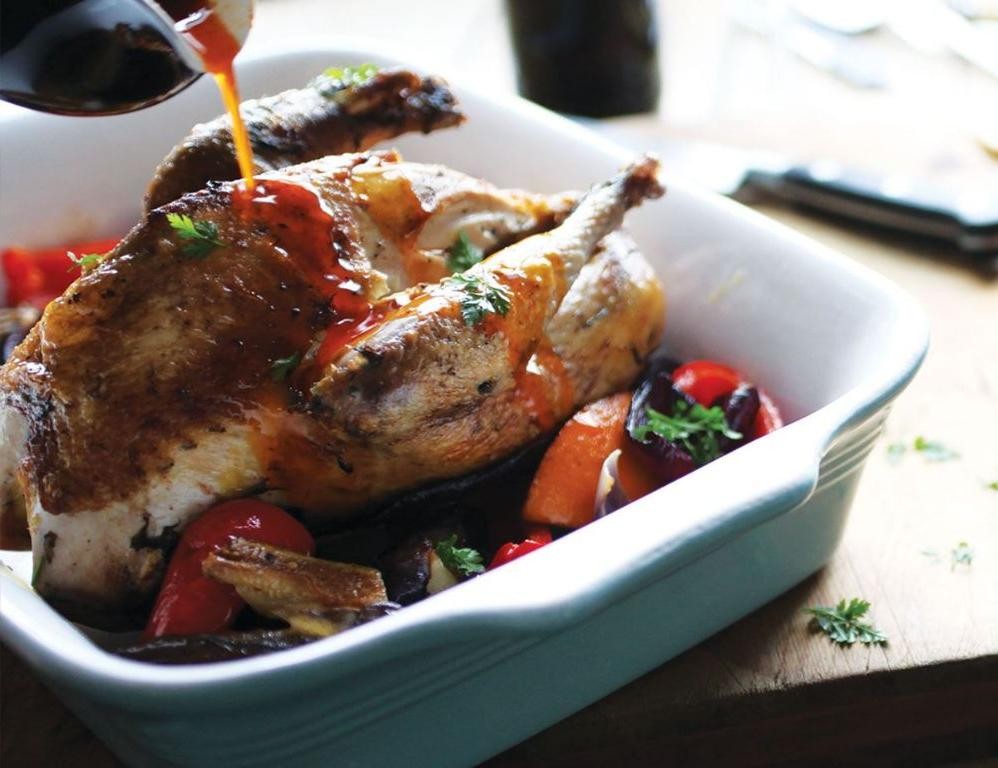
A quiet afternoon finds me returning to this simple preparation, where the golden sweetness of honey meets the earthy depth of autumn roots and wild pheasant. As the glaze caramelizes in the oven, it fills the kitchen with a scent that speaks of crisp air and falling leaves. There’s something deeply comforting in this slow-roasted dish, a gentle reminder to savor the season’s quiet gifts.
5
servings20
minutes70
minutesIngredients
- 1 whole pheasant (about 3 lbs)
- 1/4 cup honey
- 2 tbsp olive oil
- 1 tsp salt
- 1/2 tsp black pepper
- 2 large carrots
- 2 parsnips
- 1 large sweet potato
- 1 yellow onion
Instructions
- Preheat your oven to 375°F.
- Pat the pheasant completely dry with paper towels.
- Rub the pheasant all over with 1 tablespoon of olive oil.
- Sprinkle the salt and black pepper evenly over the entire surface of the pheasant.
- Peel the carrots and cut them into 2-inch chunks.
- Peel the parsnips and cut them into 2-inch chunks.
- Peel the sweet potato and cut it into 2-inch cubes.
- Peel the onion and cut it into 1-inch wedges.
- Toss the carrots, parsnips, sweet potato, and onion with the remaining 1 tablespoon of olive oil in a large roasting pan.
- Place the pheasant breast-side up on top of the vegetables in the roasting pan.
- Roast the pheasant and vegetables in the preheated oven for 45 minutes.
- Warm the honey in a small saucepan over low heat for 1 minute until it becomes fluid.
- Remove the roasting pan from the oven and brush the pheasant generously with the warmed honey.
- Return the pan to the oven and continue roasting for another 20-25 minutes.
- Check that the pheasant is fully cooked by inserting an instant-read thermometer into the thickest part of the thigh; it should read 165°F.
- Remove the pan from the oven and let the pheasant rest for 10 minutes before carving.
For me, the tender pheasant falls away from the bone, its skin lacquered and crisp against the honey’s gentle sweetness. Those roasted roots soften into caramelized edges, their earthy notes balancing the glaze. I love serving it family-style on a large platter, scattered with fresh thyme, as the evening light fades outside.
Smoky Pheasant with Pomegranate and Mint Salad
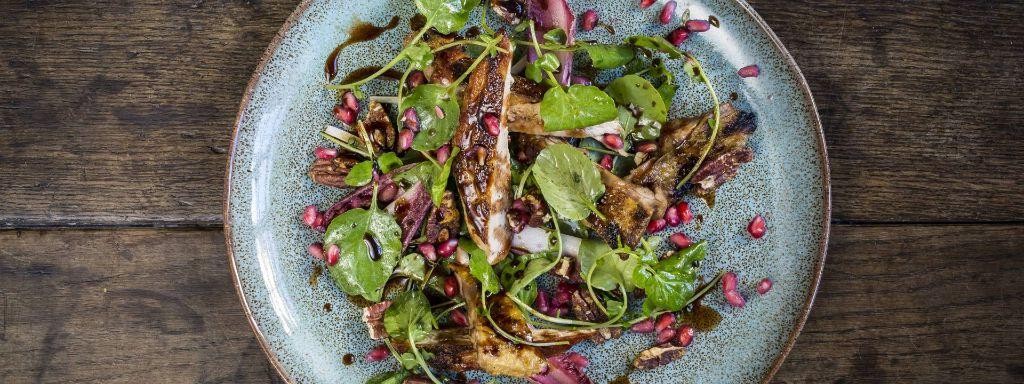
Beneath the golden October light, I find myself drawn to the quiet ritual of preparing this dish, where the earthy richness of pheasant meets the bright burst of pomegranate in a dance of flavors that feels both ancient and comforting. There’s something deeply satisfying about working with these ingredients, each step unfolding slowly like the turning of leaves outside my window. This meal carries the warmth of autumn in every bite, a gentle reminder to savor these fleeting seasonal moments.
2
portions15
minutes60
minutesIngredients
– 1 whole pheasant (about 3 pounds)
– 2 tablespoons olive oil
– 1 teaspoon smoked paprika
– 1/2 teaspoon salt
– 1/4 teaspoon black pepper
– 1 cup pomegranate seeds
– 1/4 cup fresh mint leaves
– 2 tablespoons lemon juice
– 1 tablespoon honey
Instructions
1. Preheat your oven to 375°F and position the rack in the center.
2. Pat the pheasant completely dry with paper towels, including inside the cavity.
3. Rub the pheasant evenly with 1 tablespoon olive oil, making sure to coat all surfaces.
4. Combine smoked paprika, salt, and black pepper in a small bowl.
5. Sprinkle the spice mixture evenly over the entire pheasant, including under the wings and legs.
6. Place the pheasant breast-side up in a roasting pan fitted with a rack.
7. Roast at 375°F for 45 minutes, until the skin is golden brown and crispy.
8. Check for doneness by inserting a meat thermometer into the thickest part of the thigh—it should read 165°F.
9. Remove the pheasant from the oven and let it rest on a cutting board for 15 minutes.
10. While the pheasant rests, combine pomegranate seeds and mint leaves in a medium bowl.
11. Whisk together remaining 1 tablespoon olive oil, lemon juice, and honey in a small bowl until emulsified.
12. Pour the dressing over the pomegranate and mint mixture, tossing gently to combine.
13. Carve the pheasant into serving pieces, being careful to preserve the crispy skin.
14. Arrange the carved pheasant on a platter and spoon the pomegranate mint salad over the top.
A final harmony emerges when the tender, smoky pheasant meets the crisp, jewel-like salad, the mint providing a cooling counterpoint to the rich meat. I love serving this family-style on a large wooden board, letting everyone help themselves while the aromas fill the room. The contrast between warm pheasant and cool salad creates a beautiful balance that feels both elegant and completely approachable.
Garlic Butter Pheasant with Cider Reduction
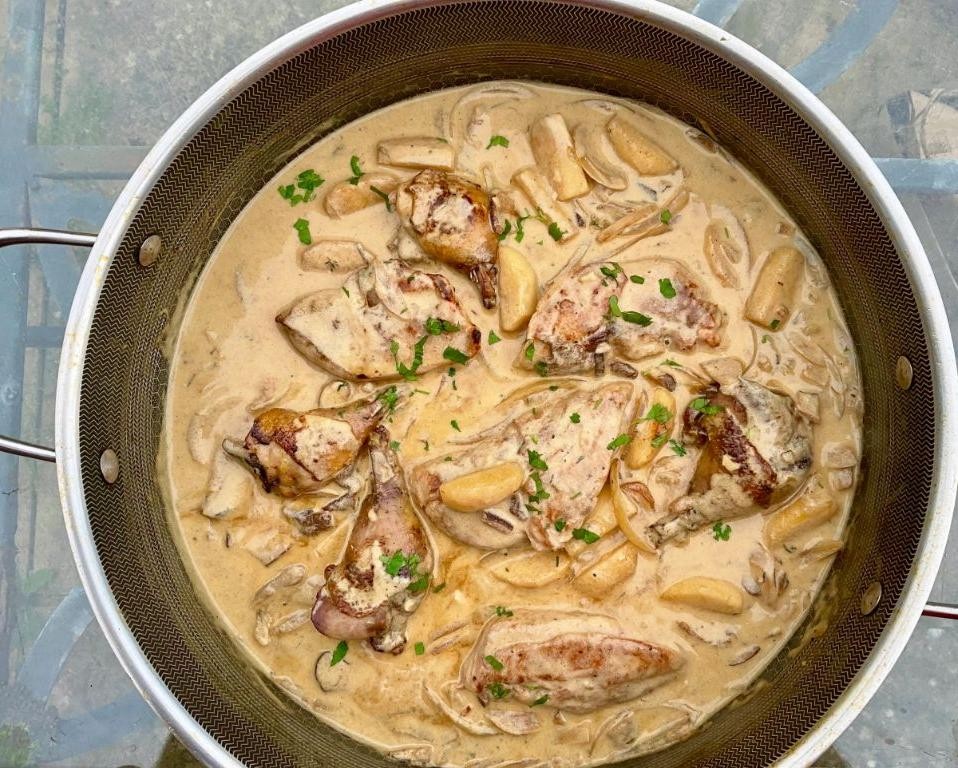
Cradling the wild pheasant in my hands this afternoon, I remembered how autumn’s crisp air always calls for meals that warm from the inside out, how the golden light of October seems to seep into every ingredient. There’s something quietly comforting about preparing a dish that honors both the season and the stillness of an empty kitchen, where each step unfolds like a slow, deliberate breath. This garlic butter pheasant with cider reduction feels like that kind of meal—simple, earthy, and deeply satisfying, a quiet celebration of fall’s gentle offerings.
5
portions15
minutes60
minutesIngredients
– 1 whole pheasant (about 2.5 lbs)
– 4 tbsp unsalted butter
– 6 cloves garlic
– 1 cup apple cider
– 1/2 cup chicken broth
– 2 tbsp olive oil
– 1 tsp fresh thyme leaves
– 1/2 tsp salt
– 1/4 tsp black pepper
Instructions
1. Pat the pheasant completely dry with paper towels inside and out to ensure crispy skin.
2. Season the pheasant evenly inside and out with 1/2 tsp salt and 1/4 tsp black pepper.
3. Heat 2 tbsp olive oil in a large oven-safe skillet over medium-high heat until shimmering.
4. Place the pheasant breast-side down in the hot skillet and sear for 5 minutes until golden brown.
5. Flip the pheasant and sear the back for another 5 minutes until evenly browned.
6. Transfer the skillet to a preheated 375°F oven and roast for 35 minutes.
7. Remove the skillet from the oven and transfer the pheasant to a cutting board to rest for 10 minutes.
8. While the pheasant rests, melt 4 tbsp unsalted butter in the same skillet over medium heat.
9. Add 6 cloves minced garlic and sauté for 1 minute until fragrant but not browned.
10. Pour in 1 cup apple cider and 1/2 cup chicken broth, scraping up any browned bits from the pan bottom.
11. Simmer the sauce for 8-10 minutes until reduced by half and slightly thickened.
12. Stir in 1 tsp fresh thyme leaves and simmer for 1 more minute.
13. Carve the rested pheasant into serving pieces.
14. Spoon the warm cider reduction over the carved pheasant before serving. Nothing compares to the way the tender, juicy pheasant melds with the rich, silky reduction—each bite carries the sweet-tart essence of apples and the earthy depth of thyme. Nestle it beside roasted root vegetables or a simple wild rice pilaf to let the flavors shine, or save any extra reduction to drizzle over mashed potatoes the next day, because some meals are too good to enjoy just once.
Bacon-Wrapped Pheasant with Maple Dijon Glaze
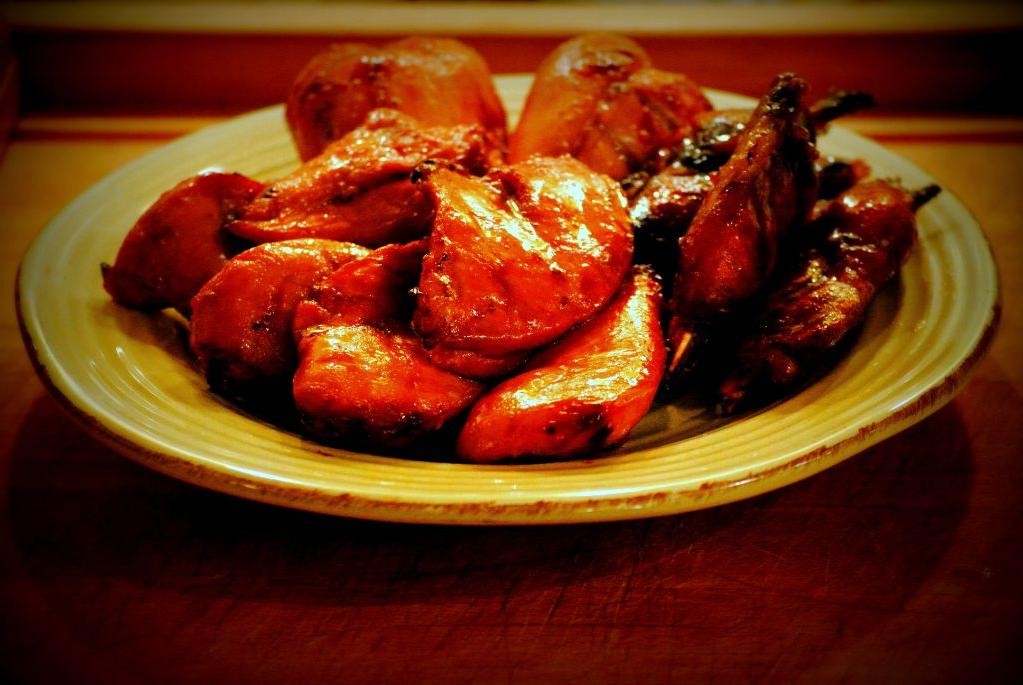
Falling leaves always bring me back to this quiet kitchen ritual, where the crisp autumn air outside seems to whisper for something hearty yet elegant to emerge from the oven. This particular preparation feels like wrapping comfort in a savory blanket, with sweet notes dancing through the steam that rises when you first slice into it. There’s a gentle satisfaction in how the flavors deepen together, creating a dish that feels both rustic and refined.
2
portions15
minutes70
minutesIngredients
– 2 whole pheasants
– 12 slices thick-cut bacon
– 1/2 cup pure maple syrup
– 1/4 cup Dijon mustard
– 2 tbsp olive oil
– 1 tsp kosher salt
– 1/2 tsp black pepper
– 1/2 tsp garlic powder
– 1/4 tsp smoked paprika
Instructions
1. Preheat your oven to 375°F and position a rack in the center.
2. Pat the pheasants completely dry with paper towels to ensure crispy skin.
3. Rub olive oil evenly over both pheasants, covering all surfaces.
4. Combine kosher salt, black pepper, garlic powder, and smoked paprika in a small bowl.
5. Season the pheasants inside and out with the spice mixture.
6. Whisk together maple syrup and Dijon mustard in another bowl until smooth.
7. Wrap 6 bacon slices around each pheasant, overlapping slightly to cover the breast meat completely.
8. Place the bacon-wrapped pheasants breast-side up in a roasting pan.
9. Brush half of the maple Dijon glaze over the pheasants, coating the bacon thoroughly.
10. Roast for 45 minutes at 375°F until the bacon begins to crisp.
11. Brush the remaining glaze over the pheasants, being careful not to tear the bacon.
12. Continue roasting for another 20-25 minutes until the internal temperature reaches 165°F when measured in the thickest part of the thigh.
13. Remove from oven and let rest for 10 minutes before carving to allow juices to redistribute.
14. Carve the pheasants, serving with the pan juices drizzled over top.
Glistening with that sweet-savory glaze, the pheasant emerges tender and moist beneath its bacon armor. Each bite delivers a wonderful contrast between the crisp, salty bacon and the subtle game notes softened by maple warmth. I love serving it alongside roasted root vegetables that catch the dripping glaze, or over a bed of wild rice that soaks up every last bit of the rich pan juices.
Pheasant in Creamy Mustard Sauce with Tarragon
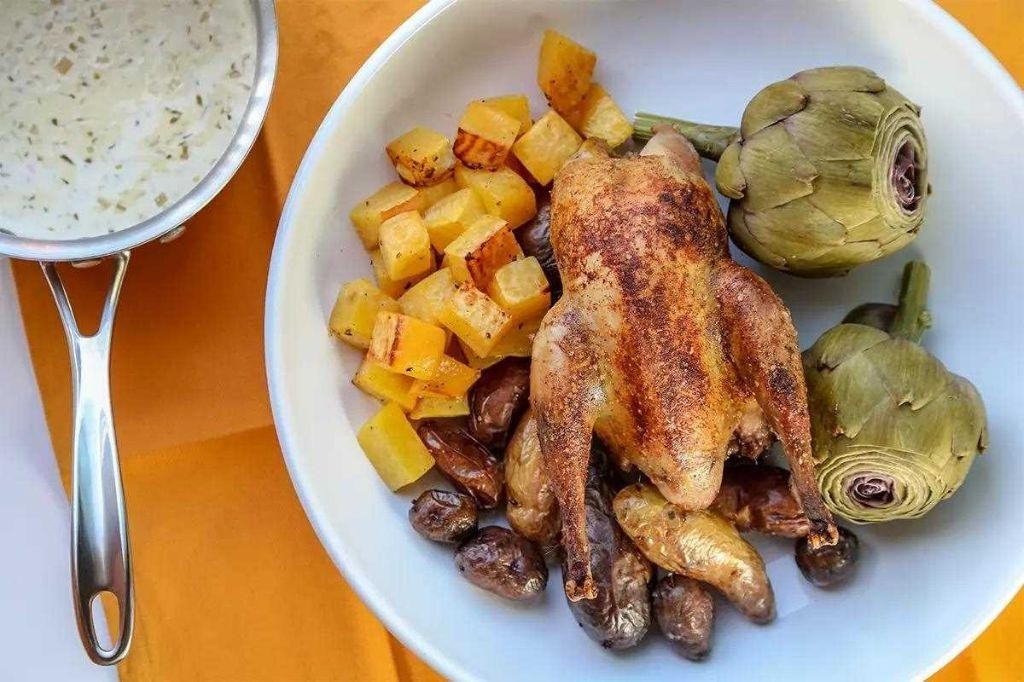
Venturing into autumn cooking always feels like returning to something deeply familiar, something that asks for patience and gentle hands in the kitchen. This creamy mustard sauce with tarragon is one of those dishes that wraps you in warmth, a quiet celebration of the season’s shift.
5
servings15
minutes59
minutesIngredients
– 1 whole pheasant, about 3 lbs
– 2 tbsp olive oil
– 1 tsp kosher salt
– 1/2 tsp black pepper
– 1 medium yellow onion
– 2 cloves garlic
– 1 cup chicken broth
– 1/2 cup heavy cream
– 2 tbsp Dijon mustard
– 1 tbsp fresh tarragon
Instructions
1. Pat the pheasant completely dry with paper towels, inside and out.
2. Rub the entire surface of the pheasant with olive oil.
3. Season the pheasant evenly with kosher salt and black pepper, including the cavity.
4. Place the pheasant breast-side up in a large oven-safe skillet or Dutch oven.
5. Roast the pheasant uncovered at 375°F for 45 minutes, until the skin is golden brown.
6. Carefully remove the pheasant from the skillet and set it on a cutting board to rest.
7. While the pheasant rests, finely dice the yellow onion and mince the garlic cloves.
8. Pour off all but 1 tablespoon of fat from the skillet, leaving the browned bits.
9. Sauté the diced onion in the skillet over medium heat for 5 minutes, until translucent.
10. Add the minced garlic and cook for 1 minute, until fragrant.
11. Pour in the chicken broth, scraping the bottom of the skillet to lift all the browned bits.
12. Simmer the broth mixture for 3 minutes, allowing it to reduce slightly.
13. Whisk in the heavy cream and Dijon mustard until the sauce is smooth and combined.
14. Chop the fresh tarragon leaves and stir them into the sauce.
15. Carve the rested pheasant into serving pieces and return them to the skillet.
16. Spoon the creamy mustard sauce over the pheasant pieces to coat them thoroughly.
17. Simmer the pheasant in the sauce over low heat for 5 minutes, until heated through.
Consider how the creamy sauce clings to the tender pheasant, its sharp mustard edge softened by the subtle anise notes of tarragon. Serving it over a bed of buttered egg noodles or alongside roasted root vegetables makes for a deeply satisfying meal that honors the quiet beauty of fall evenings.
Lemon and Thyme Roasted Pheasant with Asparagus
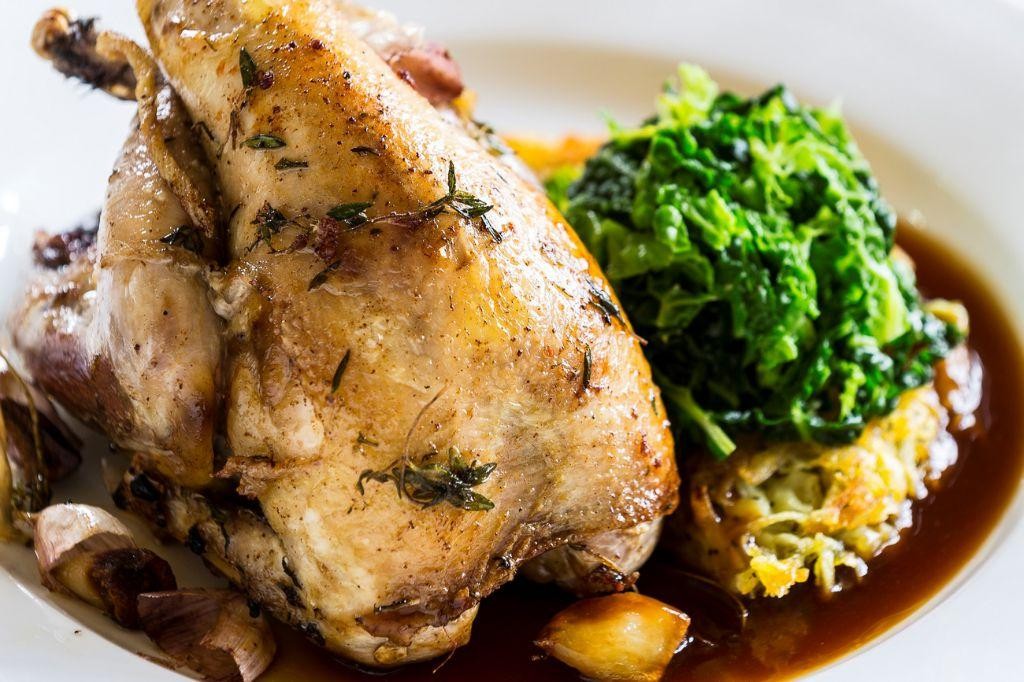
Dappled afternoon light filters through the kitchen window as I prepare this rustic dish, the kind of meal that feels like wrapping yourself in a warm blanket on a crisp autumn day. There’s something deeply comforting about the earthy aroma of thyme mingling with bright lemon notes, a simple yet elegant combination that transforms humble ingredients into something memorable.
2
portions15
minutes65
minutesIngredients
– 1 whole pheasant (3-4 pounds)
– 2 tablespoons olive oil
– 1 tablespoon fresh thyme leaves
– 1 lemon
– 1 pound asparagus
– 1 teaspoon kosher salt
– 1/2 teaspoon black pepper
Instructions
1. Preheat your oven to 375°F and position the rack in the center of the oven.
2. Pat the pheasant completely dry with paper towels, including inside the cavity.
3. Rub the entire pheasant with 2 tablespoons of olive oil, ensuring even coverage.
4. Sprinkle 1 teaspoon of kosher salt and 1/2 teaspoon of black pepper over the bird, including inside the cavity.
5. Gently separate 1 tablespoon of fresh thyme leaves from their stems and press them onto the pheasant’s skin.
6. Cut the lemon in half and squeeze the juice from one half over the pheasant.
7. Place the squeezed lemon half and the remaining whole half inside the pheasant cavity.
8. Arrange the pheasant breast-side up in a roasting pan and place it in the preheated oven.
9. Roast for 45 minutes at 375°F until the skin is golden brown and crispy.
10. While the pheasant roasts, trim the tough ends from 1 pound of asparagus by snapping them where they naturally break.
11. After 45 minutes, remove the roasting pan from the oven and arrange the asparagus around the pheasant.
12. Return the pan to the oven and continue roasting for 15-20 minutes until the pheasant reaches 165°F internally and the asparagus is tender-crisp.
13. Remove the pan from the oven and transfer the pheasant to a cutting board to rest for 10 minutes before carving.
14. Carve the pheasant, serving it alongside the roasted asparagus.
The pheasant emerges with crackling golden skin giving way to remarkably moist, tender meat infused with herbal notes, while the asparagus provides a bright, crisp counterpoint. I love serving this family-style on a large wooden board, letting everyone help themselves to generous portions alongside crusty bread for soaking up the lemony pan juices.
Spice-Rubbed Pheasant with Blackcurrant Sauce
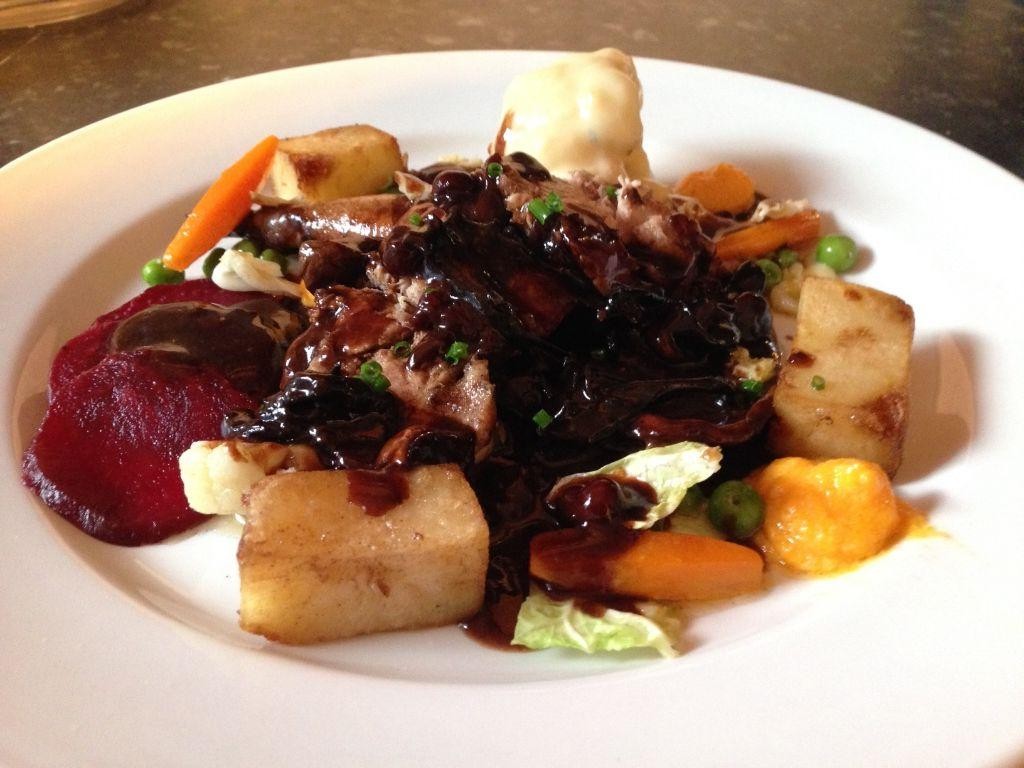
Venturing into autumn cooking always feels like unfolding a cherished story, one where the crisp air invites richer flavors and deeper connections to the land. This spice-rubbed pheasant, glazed with a blackcurrant sauce, is one of those recipes that slows time, allowing each step to be a quiet meditation on seasonal bounty. It’s a dish that rewards patience with layers of warmth and a subtle, fruity tang that clings to the memory long after the plate is cleared.
3
portions15
minutes75
minutesIngredients
– 1 whole pheasant (about 3 lbs)
– 2 tbsp olive oil
– 1 tbsp smoked paprika
– 1 tsp ground cumin
– 1 tsp dried thyme
– 1/2 tsp garlic powder
– 1/2 tsp salt
– 1/4 tsp black pepper
– 1 cup blackcurrant jam
– 1/4 cup red wine vinegar
– 1/2 cup chicken broth
– 1 tbsp unsalted butter
Instructions
1. Preheat your oven to 375°F.
2. Pat the pheasant completely dry with paper towels to ensure crisp skin.
3. In a small bowl, combine the smoked paprika, ground cumin, dried thyme, garlic powder, salt, and black pepper.
4. Rub the olive oil evenly over the entire surface of the pheasant.
5. Sprinkle the spice mixture over the pheasant, massaging it into the skin and cavity.
6. Place the pheasant breast-side up in a roasting pan fitted with a rack.
7. Roast the pheasant for 45 minutes.
8. While the pheasant roasts, combine the blackcurrant jam, red wine vinegar, and chicken broth in a small saucepan.
9. Bring the sauce to a simmer over medium heat, stirring occasionally until the jam dissolves completely.
10. Reduce the heat to low and let the sauce simmer gently for 10 minutes until slightly thickened.
11. Remove the saucepan from the heat and whisk in the unsalted butter until the sauce is glossy.
12. After 45 minutes of roasting, brush half of the blackcurrant sauce over the pheasant.
13. Continue roasting the pheasant for another 15-20 minutes until the internal temperature reaches 165°F when measured at the thickest part of the thigh.
14. Let the pheasant rest for 10 minutes before carving to allow the juices to redistribute.
15. Serve the carved pheasant with the remaining blackcurrant sauce drizzled over top. Aromatic and tender, the pheasant’s skin crisps under the spice rub while the blackcurrant sauce lends a glossy, tart-sweet balance that cuts through the richness. Consider serving it alongside roasted root vegetables or a wild rice pilaf to soak up every last drop of the deeply flavored sauce.
Roast Pheasant with Apple and Cranberry Stuffing
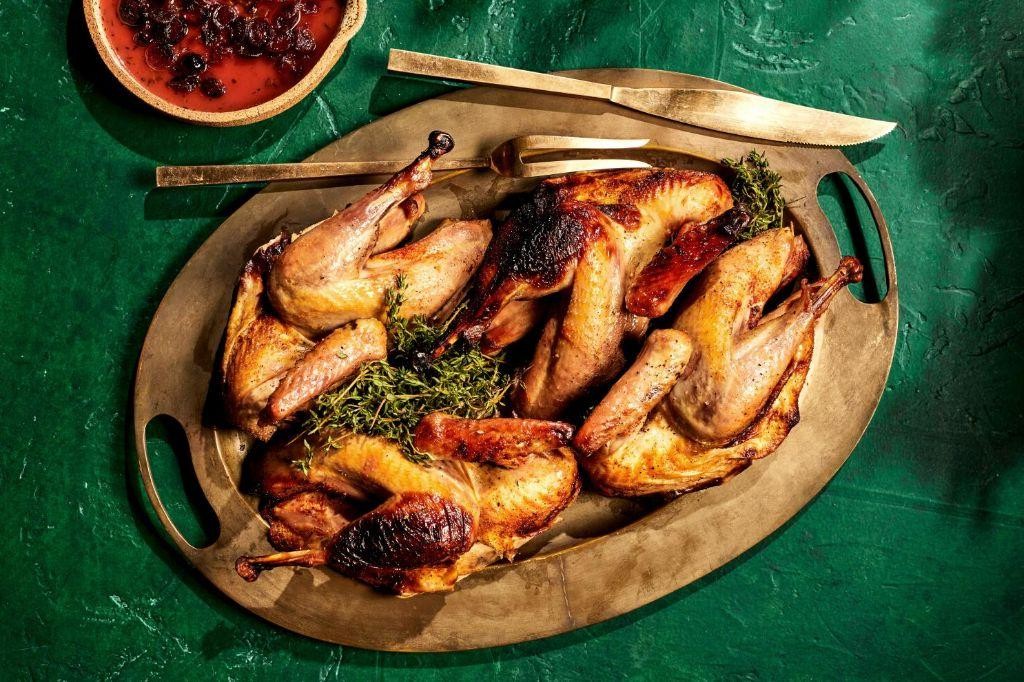
Evenings like this, when the air turns crisp and the leaves begin their fiery transformation, my thoughts drift to the quiet comfort of roasting something special, something that fills the kitchen with the warm, earthy scent of autumn and the sweet, tart promise of the season’s best fruits.
2
servings20
minutes75
minutesIngredients
– 1 whole pheasant (about 3 lbs)
– 1 tbsp olive oil
– 1 tsp salt
– 1/2 tsp black pepper
– 2 cups cubed day-old bread
– 1 cup diced apple
– 1/2 cup dried cranberries
– 1/4 cup chopped onion
– 1/4 cup chopped celery
– 1/4 cup unsalted butter, melted
– 1 tbsp fresh sage, chopped
– 1/2 cup chicken broth
Instructions
1. Preheat your oven to 375°F.
2. Pat the pheasant completely dry with paper towels inside and out.
3. Rub the pheasant all over with 1 tablespoon of olive oil.
4. Season the pheasant inside and out with 1 teaspoon of salt and 1/2 teaspoon of black pepper.
5. Combine 2 cups of cubed day-old bread, 1 cup of diced apple, 1/2 cup of dried cranberries, 1/4 cup of chopped onion, and 1/4 cup of chopped celery in a large bowl.
6. Pour 1/4 cup of melted unsalted butter over the bread mixture and toss to coat.
7. Stir in 1 tablespoon of fresh chopped sage.
8. Gradually add 1/2 cup of chicken broth to the stuffing mixture until it just holds together when pressed.
9. Loosely fill the pheasant cavity with the prepared stuffing.
10. Truss the pheasant with kitchen twine to help it cook evenly.
11. Place the pheasant breast-side up in a roasting pan fitted with a rack.
12. Roast at 375°F for 60-75 minutes, until the internal temperature at the thickest part of the thigh reaches 165°F.
13. Let the pheasant rest for 15 minutes before carving to allow the juices to redistribute.
14. Remove the stuffing from the cavity and serve alongside the carved pheasant.
Layers of tender, gamey pheasant meld beautifully with the sweet-tart stuffing, where soft apples and plump cranberries create pockets of bright flavor against the savory, herb-kissed bread. For a truly memorable presentation, serve it on a large wooden board surrounded by roasted root vegetables, letting the deep golden skin and jewel-toned stuffing take center stage.
Pheasant with Wild Rice and Almond Pilaf
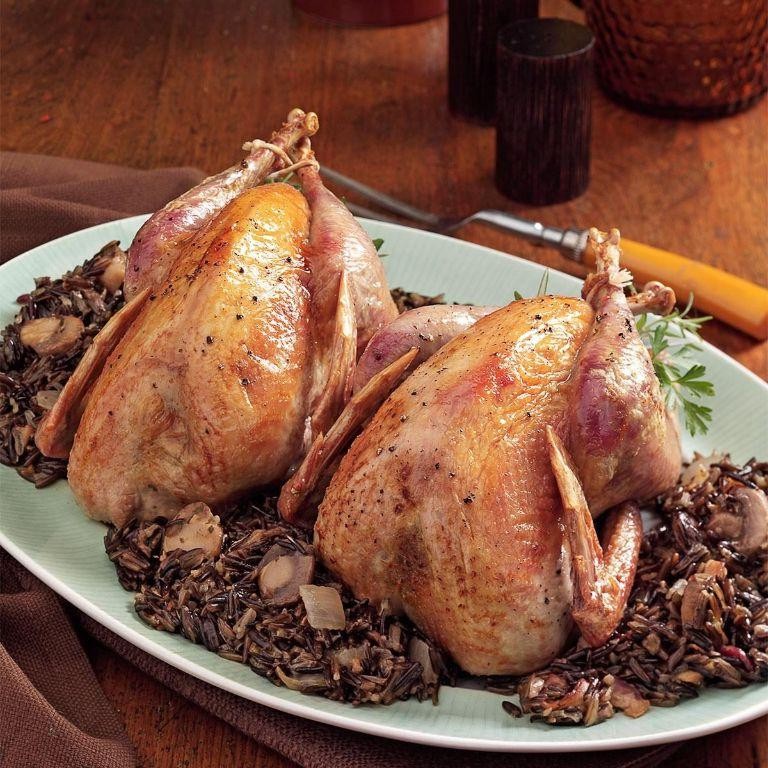
Sitting here with the golden light of late afternoon filtering through the kitchen window, I find myself drawn to recipes that feel like quiet conversations with the season, like this pheasant dish that bridges the warmth of the oven with the earthy comfort of wild rice.
2
portions15
minutes115
minutesIngredients
– 1 whole pheasant (about 3 lbs)
– 2 tbsp olive oil
– 1 tsp salt
– 1/2 tsp black pepper
– 1 cup wild rice blend
– 2 cups chicken broth
– 1/2 cup sliced almonds
– 1/4 cup dried cranberries
– 1 small yellow onion, diced
– 2 cloves garlic, minced
– 1 tbsp fresh thyme leaves
Instructions
1. Preheat your oven to 375°F and pat the pheasant completely dry with paper towels.
2. Rub the pheasant inside and out with olive oil, then season evenly with salt and black pepper.
3. Place the pheasant breast-side up in a roasting pan and roast for 45-50 minutes until the internal temperature reaches 165°F at the thickest part of the thigh.
4. While the pheasant roasts, rinse the wild rice blend under cold water until the water runs clear to remove excess starch.
5. In a medium saucepan, toast the sliced almonds over medium heat for 3-4 minutes until fragrant and lightly golden, then remove from pan.
6. Sauté the diced onion in the same pan for 5-6 minutes until translucent and softened.
7. Add the minced garlic and cook for 1 minute until fragrant but not browned.
8. Stir in the rinsed wild rice blend and cook for 2 minutes to lightly toast the grains.
9. Pour in the chicken broth and bring to a boil, then reduce heat to low, cover, and simmer for 45 minutes until the rice is tender and liquid is absorbed.
10. Remove the rice from heat and let stand covered for 10 minutes to finish steaming.
11. Fluff the rice with a fork and stir in the toasted almonds, dried cranberries, and fresh thyme leaves.
12. Let the roasted pheasant rest for 15 minutes before carving to allow the juices to redistribute.
Even the quietest meals can feel like celebrations when the textures play together so beautifully—the tender pheasant yielding to the knife, the wild rice offering its nutty chew, the almonds providing their gentle crunch. I love serving this with the pilaf mounded high on the plate, the pheasant arranged alongside, and perhaps a simple green salad to complete the autumn tableau.
Roasted Pheasant with Shallot and Rosemary Gravy
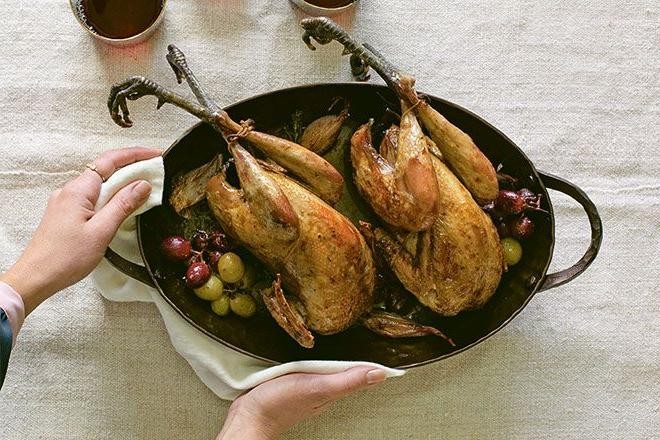
Venturing into autumn’s embrace, there’s something profoundly comforting about preparing a roasted bird that fills the kitchen with earthy aromas and promises warmth at the table. This roasted pheasant recipe, with its simple yet elegant shallot and rosemary gravy, feels like a quiet celebration of the season’s bounty. It’s the kind of meal that invites you to slow down and savor each step, from preparation to that first tender bite.
2
servings15
minutes70
minutesIngredients
– 1 whole pheasant (3-4 pounds)
– 2 tablespoons olive oil
– 1 teaspoon kosher salt
– 1/2 teaspoon black pepper
– 4 medium shallots
– 2 sprigs fresh rosemary
– 1/4 cup dry white wine
– 1 cup chicken broth
– 1 tablespoon all-purpose flour
– 2 tablespoons unsalted butter
Instructions
1. Preheat your oven to 375°F and position the rack in the center.
2. Pat the pheasant completely dry inside and out with paper towels.
3. Rub the entire surface of the pheasant with olive oil, ensuring even coverage.
4. Season the pheasant inside and out with kosher salt and black pepper.
5. Place the pheasant breast-side up in a roasting pan fitted with a rack.
6. Roast for 50-60 minutes until the internal temperature reaches 165°F when measured at the thickest part of the thigh.
7. Tip: For extra crispy skin, increase the oven temperature to 425°F for the final 10 minutes of cooking.
8. Remove the pheasant from the oven and transfer to a cutting board to rest for 15 minutes.
9. While the pheasant rests, peel and thinly slice the shallots.
10. Place the roasting pan with drippings over medium heat on the stovetop.
11. Add the sliced shallots and cook for 3-4 minutes until softened and translucent.
12. Strip the rosemary leaves from their stems and chop them finely.
13. Sprinkle the flour over the shallots and cook for 1 minute while stirring constantly.
14. Tip: Cooking the flour for a full minute eliminates any raw flour taste from your gravy.
15. Pour in the white wine, scraping up all the browned bits from the bottom of the pan.
16. Add the chicken broth and chopped rosemary, whisking continuously.
17. Simmer the gravy for 5-7 minutes until it thickens to coat the back of a spoon.
18. Tip: For a silky smooth gravy, strain it through a fine-mesh sieve before serving.
19. Whisk in the butter until fully incorporated and the gravy becomes glossy.
20. Carve the rested pheasant and serve immediately with the warm gravy. Under the crisp, golden-brown skin lies incredibly moist, tender meat that falls away from the bone with gentle pressure. The gravy brings a subtle sweetness from the caramelized shallots and woodsy fragrance from the rosemary, creating a beautiful harmony with the pheasant’s rich flavor. Consider serving it alongside roasted root vegetables or over creamy polenta to soak up every last drop of the aromatic sauce.
Conclusion
Mastering roast pheasant has never been more accessible with these 28 irresistible recipes. Whether you’re a seasoned cook or trying game for the first time, there’s something here to delight every palate. We’d love to hear which recipes become your favorites—drop us a comment below! Don’t forget to share this collection on Pinterest so fellow food lovers can discover these delicious dishes too.
